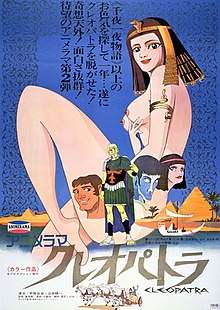Cleopatra (1970 film)
| Cleopatra | |
|---|---|
 Japanese poster art, featuring Cleopatra (top) and Antonius, Caesar, Octavian, and Lybia (bottom, left to right) | |
| Japanese | クレオパトラ |
| Hepburn | Kureopatora |
| Directed by |
Osamu Tezuka Eiichi Yamamoto |
| Produced by |
Osamu Tezuka Yasuhiko Yoneyama |
| Written by | Shigemi Satoyoshi |
| Starring | Chinatsu Nakayama |
| Music by | Isao Tomita |
| Cinematography | Tsuyoshi Honda |
| Distributed by | Nippon Herald Movies |
Release date |
|
Running time | 112 minutes |
| Country | Japan |
| Language | Japanese |
Cleopatra (Japanese: クレオパトラ Hepburn: Kureopatora) is a 1970 Japanese animated comedy film directed by Osamu Tezuka and Eiichi Yamamoto. The film was a commercial failure.
Plot
In the far future, three humans—Jiro, Harvey, and Mary—discover that an alien race called the Pasateli intends to conquer humankind by the mysterious "Cleopatra plan". Through the use of a time machine, the three transport their minds into the bodies of members of the historical Cleopatra's court to discover and stop the plan. Harvey, however, vows to use the opportunity to secure the title of the greatest lover who ever lived by having sex with Cleopatra.
In the middle of the Roman conquest of Egypt, a group of Egyptians secretly plot a rebellion to overthrow Julius Caesar. The group plans to send Cleopatra to first seduce and then murder Caesar. The Romans discover the group and attack them. Cleopatra escapes, along with her handmaidens Lybia and Apollodoria. Cleopatra goes to an ancient wizard, who magically grants her an irresistibly seductive body for her mission.
It is at this point that the Jiro, Harvey, and Mary arrive: Mary is now Lybia, and Harvey finds himself in the body of the wizard's pet leopard Rupa, thwarting his plans to seduce Cleopatra. They accompany Cleopatra to meet Caesar, who is so overcome by her beauty that he makes her queen of Egypt. Jiro finds himself in the body of Ionius, a Greek man captured and enslaved by the Romans. Ionius frees himself and the other slaves by using his knowledge of future technology to make modern hand grenades. Caesar recaptures Ionius and, amused by his fighting skills, orders him to fight in the gladiatorial arena. He gives Ionius a gun to ensure his victory. Ionius proves so popular with the Roman public that Caesar's own popularity soars, leading his senators to conspire to murder both him and Ionis and end their influence.
Lybia and Apollodoria insist that Cleopatra must murder Caesar; Cleopatra, however, has had a change of heart and keeps putting off the assassination in favor of sex. They accompany Caesar back to Rome, just in time for him to be assassinated by his own senators. Octavian—soon to be called Augustus Caesar—takes command. Cleopatra tries to continue the plan by seducing Augustus, only to find that he is homosexual and impervious to her charms. Augustus, however, is attracted to Ionius and spares his life. Disappointed by the rejection, Cleopatra commits suicide.
The time travelers return to the future and report that the Cleopatra plan is a scheme by the Pasateli to assume the form of beautiful human women to seduce and destroy Earth's most powerful male leaders. The Pasateli have already taken their human forms and are poised to strike when this information arrives, but Earth is able to root them out and save the world in time.
Cast
- Chinatsu Nakayama as Cleopatra
- Hajime Hana as Julius Caesar
- Osami Nabe as Marcus Antonius
- Jitsuko Yoshimura as Lybia
- Tsubame Yanagiya as Rupa
- Nobuo Tsukamoto as Ionius
- Kazuko Imai as Calpania
- Susumu Abe as Cabagonis
- Yoshirō Katō as Chief Tarabahha
- Nachi Nozawa as Octavian
Production and release
In 1972, Mushi Productions, who made the film, accepted a deal with Xanadu Productions, a small company, to release an English-dubbed version in the United States to try to save themselves from bankruptcy. When it was released in the United States, Xanadu changed the title to Cleopatra: Queen of Sex and released it with a self-applied X-rating on April 24, 1972. It was advertised as the first X-rated pornographic animated movie in the United States. However, Fritz the Cat came out with its X-rating from the MPAA before it on April 18, 1972.
The English version and the original version were not received well by critics and audiences, and was not a success at the box office, due to it not exactly being a pornographic movie (together with its competitor), with people even wanting theaters to refund their money.
Howard Thompson of The New York Times said it was basically a movie that involved "mostly a voluptuously drawn Cleopatra and a bevy of cuties that trot around bare breasted." Variety called the movie "partly sophomoric", with "emphasis on vulgar low comedy", but praised it for having "good animation and color."
Cleopatra was not submitted to the MPAA, and may not have received an X-rating if it had been. The English dub and subtitled version is said to be lost. DVDs of the film do exist.[1]
See also
References
- ↑ Michael Barrier. "The Filming of Fritz the Cat". Funnyworld, Nos. 14 and 15. Retrieved 2007-01-15.
External links
- Cleopatra on IMDb
- Cleopatra (anime) at Anime News Network's encyclopedia
- Cleopatra in the TezukaOsamu.net database